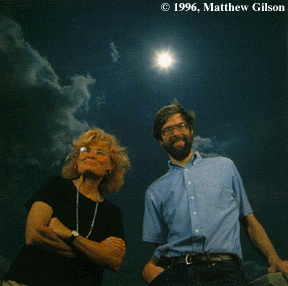
The University of Chicago Magazine
August 1996

Forecast: Cloudy
Mapping our interstellar neighborhood reveals the solar system's good fortune--and what may loom ahead.
 Solar vision: Astronomers Frisch and Welty say big changes may await the Sun in space.
Solar vision: Astronomers Frisch and Welty say big changes may await the Sun in space.If "may you live in interesting times" can be called a curse, then the Sun and its planets have been enjoying a four- or five-million-year-long blessing: a monotonous interstellar environment. But the boring days, says astronomer Priscilla Frisch, are at an end. In its lazy orbit around the center of the Milky Way galaxy, our solar system recently glided out of a zone almost devoid of matter and into a much more "interesting" locale.
While the gas-and-dust cloud surrounding the solar system today is mostly low in density, Frisch's latest research--done with fellow Chicago researcher Daniel Welty, SM'79, PhD'85, and reported at the American Astronomical Society's June meeting--may have spotted rough weather ahead: a cloud region Frisch describes as "possibly a million times denser than what we're in now." Some 50,000 years in the future, it could affect conditions on Earth.
Frisch, who has spent more than two decades studying the Sun's local neighborhood, reported in 1994 that the solar system entered the low-density cloud less than 10,000 years ago. That gossamer structure, she believes, is part of a narrow band belonging to a giant shell of gas, or "superbubble," which is sweeping space clear as it flows from an area of active star formation known as the Scorpius-Centaurus Association. Material from these stars, which lie about 600 light-years or 3,500 trillion miles away, expanded unevenly, spreading easily into the void between the Milky Way's spiral arms where the Sun was located.
Earth, for the moment, is shielded from such interstellar clouds by the solar wind, the flux of charged particles streaming from the Sun's corona. While the wind's region of influence, or heliosphere, extends 100 times farther than the Sun's distance to Earth, Frisch says the heliosphere "might have been much larger before we entered the interstellar cloud."
The heliosphere could shrink still more. If she and Welty--like Frisch, a senior research associate in astronomy & astrophysics--are correct, the Sun is headed toward a cloud sufficiently dense to compress the heliosphere to a volume not much wider than Earth's orbit. "There would be dramatic effects on the inner solar system," Frisch says. The possibilities include an increase in the cosmic-ray flux and changes in the Earth's magnetosphere, atmospheric chemistry, and perhaps even climate.
To scout out the interstellar terrain, Frisch and Welty used the Coud Feed spectrograph of the 0.9-meter telescope at Arizona's Kitt Peak National Observatory, detecting gas from the way its ionized calcium atoms block specific wavelengths of blue light from nearby stars. For now, Frisch claims only that an upcoming dense cloud is "consistent with the data"; a positive ID requires looking at elements whose absorption in the ultraviolet spectrum is obscured by Earth's atmosphere. This summer, the Hubble Space Telescope is gathering related evidence.
Whatever Hubble finds, the Sun's uneventful past has taught Frisch a lesson. Astronomers looking for life outside our solar system should consider a star's neighborhood: "Ican't imagine that a star passing in and out of dense interstellar cloud fragments--such as a star that's traversing galactic spiral arms--would have a stable interplanetary environment. Without stability in the local stellar environment, I doubt there could be stable planetary climates hospitable to life."--A.C.
More Investigations:
Also in Investigations:
- Family income is the number one factor in determining who attends college, according to a National Opinion Research Center study.
- Encryption technology would protect individual privacy and prevent economic espionage, according to a National Research Council study led by Law School Professor Kenneth Dam.
- Graeme Bell and Nancy Cox of the BSD have narrowed the search to a region on human chromosome 2 for a gene that plays a major role in non-insulin-dependent diabetes mellitus.
Go to:
- INVESTIGATIONS
- CHICAGO JOURNAL
- EVENTS
- LETTERS
- CHICAGOPHILE
- Feature story, a profile of George Gruhn, AB'67, "Would you buy a used guitar from this man?"
- Feature story, drawings from Reunion 1996 in June, "Scenes from a Reunion"
- Feature story, a profile of Abner Mikva, JD'51, "Dissenting Opinion"
- CLASS NEWS
- DEATHS
- BOOKS
- IN THE CLUBS
- ALUMNI AWARD-WINNERS